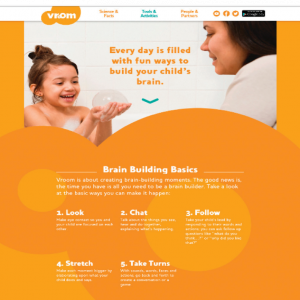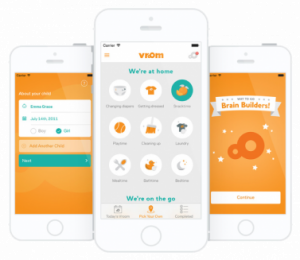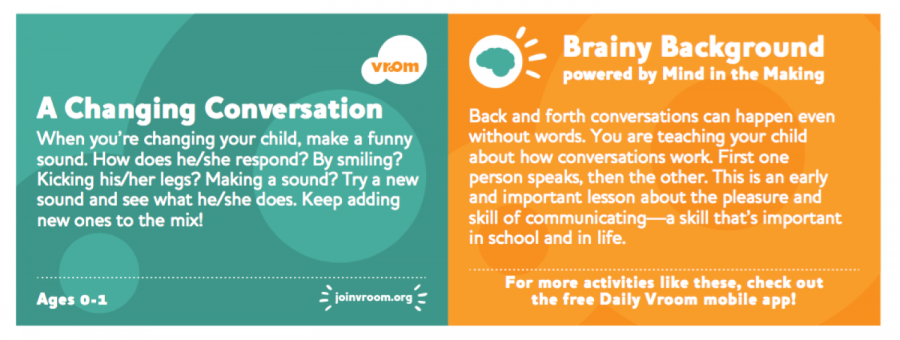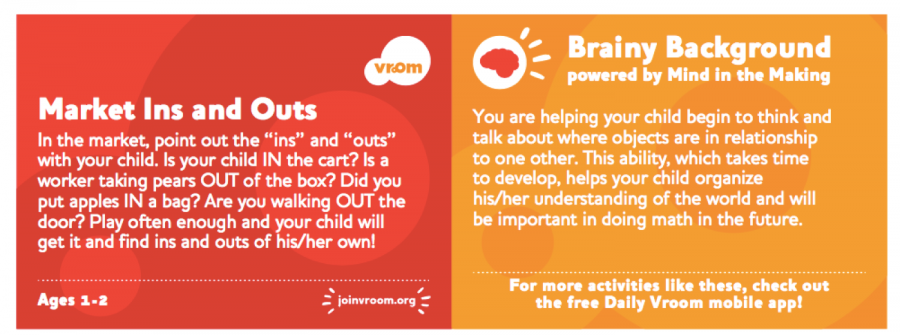Introduction to Vroom

This course and course book will reference a set of free resources called Vroom. These support young children’s learning by promoting healthy brain development through meaningful interactions with parents and caregivers during everyday activities like meals, diaper changing, or walking to the park.
Vroom Resources

Vroom resources available in English and Spanish include apps, videos, infographics, and tip cards.
Vroom free app
The app which provides daily tips and also allows a search for tips based on where people are and what they might be doing with a child. The app was designed with parents in mind, but it can serve as a resource to anyone who is working with young children.
Brain Building Basics
Other Vroom educational resources include Brain Building Basics and The Brain Story infographics.
Video: Brain Building Basics (3:03)
This video shows how parents can foster the development of their children. Let’s watch and listen for the five practices that adults can do to help young children’s brains grow.
Watch Brain Building Basics from Vroom on YouTube.

Video Debrief
The video covers five brain-building practices: (click to toggle expand or collapse)
- Look
- Follow
- Chat
- Take turns
- Stretch
These are simple concepts for how to interact with children in a way that is building brains. Goals are to give parents and educators the confidence to use skills they already have and to use everyday interactions to support children’s development.
Vroom Tips
Throughout the course book, we will discuss different Vroom tips to apply what we are learning to ways we can support children’s learning through everyday interactions. Each tip explains how to support children’s learning during an everyday interaction, such as changing a diaper. Each tip also shares the science behind why the interaction helps support children’s learning and development.
Vroom Cards
A link to the downloadable and printable cards is in the reference below and in the readings for the relevant lessons.
Vroom Tip: Changing Conversation
Tips correlate with specific periods in children’s development. The intended age range is in the bottom left-hand corner of the tip card. This particular tip is suggested for children from birth to age 1.

View text-only alternative of this Vroom card
A Changing Conversation
When you’re changing your child, make a funny sound. How does he/she respond? By smiling? Kicking his/her legs? Making a sound? Try a new sound and see what he/she does. Keep adding new ones to the mix!
Ages 0-1
Brainy Background powered by Mind in the Making
Back and forth conversations can happen even without words. You are teaching your child about how conversations work. First one person speaks, then the other. This is an early and important lesson about the pleasure and skill of communicating—a skill that’s important in school and in life.
Vroom Tip: Market Ins and Outs
This tip for children ages 1 to 2 years old has suggestions about how to help build early math skills.

View text-only alternative of this Vroom card
Market Ins and Outs
In the market, point out the “ins” and “outs” with your child. Is your child IN the card? Is a worker taking pears OUT of the box? Did you put apples IN a bag? Are you walking OUT the door? Play often enough and your child will get it and find ins and outs of his/her own!
Ages 1-2
Brainy Background powered by Mind in the Making
You are helping your child begin to think and talk about where objects are in relation to one another. This ability, which takes time to develop, helps your child organize his/her understanding of the world and will be important in doing math in the future.
Think of how you might adapt this tip to an early learning setting. One idea is: When children are playing, you can point out when they are climbing in a box, taking blocks out of a bucket, or putting toys in a cup.
Vroom Video Tip
Video: Texture Talk (1:43)
Now, we’ll watch a short video about a Vroom tip.
Think about:
- How you might use this activity in your learning program
- Similar activities that might build the same skills
This video shows a tip in action. First, the narrator reads the tip. Then a parent uses the tip activity to interact with a child. Then, the narrator reads the Brainy Background behind the tip.
Watch Texture Talk from Vroom on YouTube.

Video Debrief
How can you use this and similar activities? (click to toggle expand or collapse)
One way to use the activity in an early learning environment is for children to feel fruits on a tray or in their lunch. Similar activities might be to have children:
- Feel fabrics and compare textures.
- Put their hand in a box that they can’t see into to feel different objects and describe their textures.
Assignment: Brain-Building Tips
At the end of some lessons, you will complete a brain-building assignment.
The assignments will ask you to create brain-building tips that you or parents could use to help support young children’s learning in a particular domain, such as language development.
- The goal of these assignments is to help you synthesize the information that you have learned in the course and apply it to everyday situations.
- It will also help you to think creatively about opportunities for learning.
 References
References
Hamre, B. K., Downer, J. T., Jamil, F. M., & Pianta, R. C. (2012). Enhancing teachers’ intentional use of effective interactions with children. In R. C. Pianta (Ed.), Handbook of early childhood education (pp. 507–532). New York, NY: The Guilford Press.
Joseph, G. E., & Brennan, C. (2013). Framing quality: Annotated video-based portfolios of classroom practice by preservice teachers. Early Childhood Education Journal, 41(6).
U.S. Department of Health and Human Services, Administration for Children and Families, Office of Head Start. (n.d.). Head Start Early Learning Outcomes Framework: Ages Birth to Five. [PDF]
Vroom.(n.d.) Hello brain builder. [Website]
Vroom. (2018). Our tools and resources make it easy to get started. [Webpage]
Vroom. (2016, August 8). Brain building basics. [Video]
Vroom. (2015, September 3). Vroom video tip: Texture talk. [Video]

